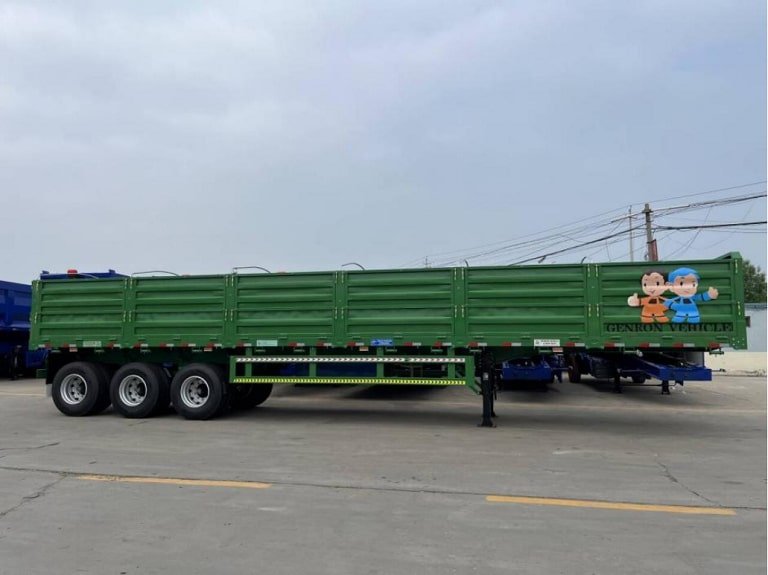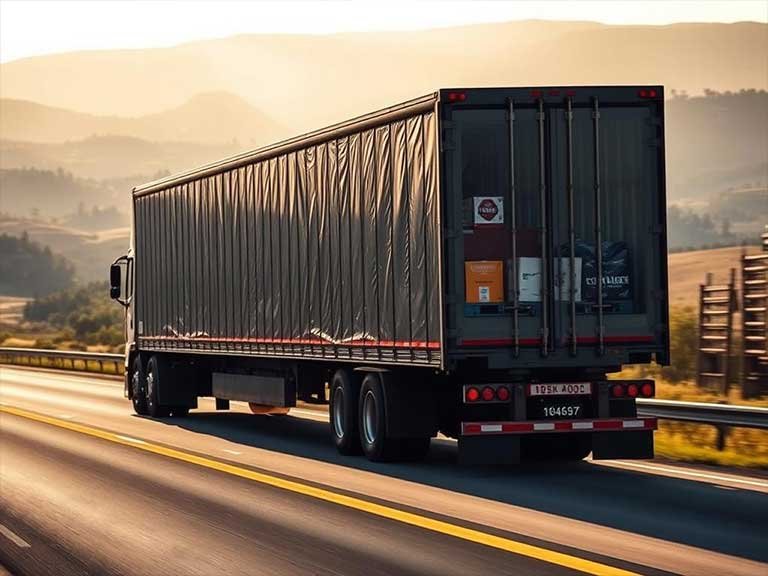Are you having trouble finding the perfect trailer for your needs? Choosing the right sidewall semi-trailer is key for safe cargo, efficiency, and cost savings in your logistics.
At Genron International Trade, we know how hard it is to pick the right trailer. We’ve been designing and making top-quality semi-trailers for years. This includes fuel tanker trailers, low-bed trailers, flatbed trailers, and rear dump trailers. We aim to give you customized solutions that fit your transportation needs.
We can help you understand what to look for in a sidewall semi-trailer. This includes structural features, load capacity, and cost. Knowing the benefits and design of sidewall semi-trailers helps you make a smart choice. This choice will boost efficiency and keep your cargo safe.
Table of Contents
Understanding Sidewall Semi-Trailer Design and Benefits
Sidewall semi-trailers are designed to protect and be easy to access. They are a versatile choice for many transportation needs. The right trailer can greatly improve your cargo transport efficiency and safety.
Key Structural Features of Sidewall Semi-Trailers
The strength of sidewall semi-trailers comes from their strong frames and durable sidewalls. These features offer extra protection for your cargo. Key features include:
- Sturdy side wall construction for partial cargo protection
- Reinforced frames for enhanced durability
Advantages Over Other Trailer Types
Sidewall semi-trailers have many benefits. They make loading and unloading easy and protect cargo better than flatbed trailers. They’re great for moving construction materials and agricultural products.
Limitations to Consider
While sidewall semi-trailers are great, they carry less cargo due to the sidewall construction. Knowing this helps you choose the right trailer type for your needs.

Assessing Your Transportation Requirements
Figuring out what you need for transportation is key to picking the right sidewall semi-trailer. Different places, like Africa and Southeast Asia, have their own challenges. These challenges come from road conditions and transportation needs.
Evaluating Cargo Type and Protection Needs
Different cargo needs different levels of protection. For example, construction materials need protection from rain but easy side access. Agricultural products might need ventilation and protection from road debris. We consider these needs to suggest the best trailer for your cargo.
Analyzing Route Conditions and Distances
The condition of your routes affects your trailer choice. Whether you’re driving on rough terrain, unpaved roads, or highways, it impacts your trailer’s durability. For long trips, choosing a trailer with aerodynamic design and fuel-efficient tires can save costs over time.
Determining Loading/Unloading Requirements
It’s important to look closely at your loading and unloading processes. Sidewall semi-trailers are very efficient for frequent side loading or multiple delivery points. We also think about the loading equipment at your pickup and delivery spots to suggest the best sidewall height and access.
Comparing Sidewall Semi-Trailers to Alternative Options
When choosing a trailer, it’s important to compare sidewall semi-trailers with other options. Different trailers meet different cargo needs. Understanding their benefits helps you make a smart choice.
Sidewall vs. Flatbed Trailers: When to Choose Each
Sidewall semi-trailers and flatbed trailers have different uses. Flatbed trailers are best for big or heavy items that don’t mind the weather. They’re easy to load from the top or back.
Sidewall trailers, on the other hand, protect against weather and road debris. They’re good for items that need some protection.
Sidewall vs. Enclosed Trailers: Protection vs. Flexibility
Enclosed trailers keep high-value or sensitive goods safe, but are hard to load and unload. Sidewall trailers offer a balance of protection and easy access. They’re great for many types of cargo.
| Trailer Type | Cargo Protection | Loading Flexibility | Fuel Efficiency |
| Sidewall Semi-Trailers | Moderate | High | Good |
| Flatbed Trailers | Low | High | Good |
| Enclosed Trailers | High | Low | Fair |
Sidewall vs. Specialized Trailers: Application-Specific Considerations
Specialized trailers are made for specific jobs, like carrying refrigerated goods or livestock. They have special features for those tasks. But sidewall semi-trailers are versatile for many cargo types. They’re useful for different transportation needs.

Key Factors in Choosing the Right Sidewall Semi-Trailer
Choosing the right sidewall semi-trailer needs careful thought. We must consider many factors that affect its performance, safety, and cost. Making the right choice is important.
Load Capacity and Weight Distribution
Load capacity is key when picking a sidewall semi-trailer. We need to think about our usual and maximum loads. The trailer must handle our needs without going over its limit. Also, how we distribute the weight is important for safety and tire wear.
Sidewall Height and Material Options
The height of the sidewall and the material used matter a lot. There are different heights and materials like aluminum, steel, and composites. Each has its own benefits in durability, weight, and cost.
Axle Configuration and Tire Selection
The axle setup affects the trailer’s weight capacity, stability, and how easy it is to move. We should pick the right setup for our loads. Choosing the right tires is also important. Things like load rating, speed rating, and tread pattern affect how well it performs and stays safe.
Cost and Maintenance Considerations
Finally, we must think about the cost of the trailer and how much it will cost to run it over time. Things like fuel efficiency, maintenance, and how long it will last are important. Keeping the trailer in good shape, like checking the sidewalls and tire pressure, helps it last longer.
Making Your Final Decision
Choosing the right sidewall semi-trailer is key. Start by making a checklist of what you need. Think about the cargo, route, load capacity, tire specs, and how efficient you want it to be.
Talk to experts and get detailed specs from companies like Genron International Trade. Look at the total cost, including fuel, tire wear, and maintenance.
Look for durability, a good support network, and safety features. This way, you find a trailer that’s safe, easy to use, and efficient for your needs.
For a custom solution, contact Genron International Trade. We can help design a trailer that fits your specific needs and goals.

FAQ
What factors should I consider when selecting trailer tires for my sidewall semi-trailer?
When picking tires, think about load capacity, type, tread, and axle setup. This ensures good performance, fuel use, and safety. A tire specialist can help pick the best tire for you.
How do I determine the ideal sidewall height for my cargo?
Consider your cargo’s size and type to find the right sidewall height. Taller sides protect bigger or odd-shaped cargo. Shorter sides work for smaller loads. Our team can guide you to the best height for your cargo.
What are the benefits of using a sidewall semi-trailer over other trailer types?
Sidewall semi-trailers are versatile and efficient for many cargo types. They offer protection and flexibility, making them great for large or odd-shaped loads. They’re also often cheaper than enclosed trailers and better than flatbeds for protecting cargo.
How do I ensure proper weight distribution on my sidewall semi-trailer?
Safe and efficient transport needs proper weight distribution. Think about cargo placement, axle setup, and load capacity. A transportation expert can help plan the best weight distribution for you.
What maintenance considerations should I keep in mind for my sidewall semi-trailer?
Regular checks and maintenance are vital for your trailer’s life. Look for wear, damage, or corrosion, and do routine tasks like lubricating hinges and checking tire pressure. Our team can offer maintenance tips and help you with a schedule.
How can I optimize fuel efficiency for my sidewall semi-trailer?
To save fuel, consider tire pressure, trailer design, and weight distribution. Proper tires, a streamlined trailer, and balanced weight can improve fuel use. A transportation expert can help find ways to cut fuel costs.


